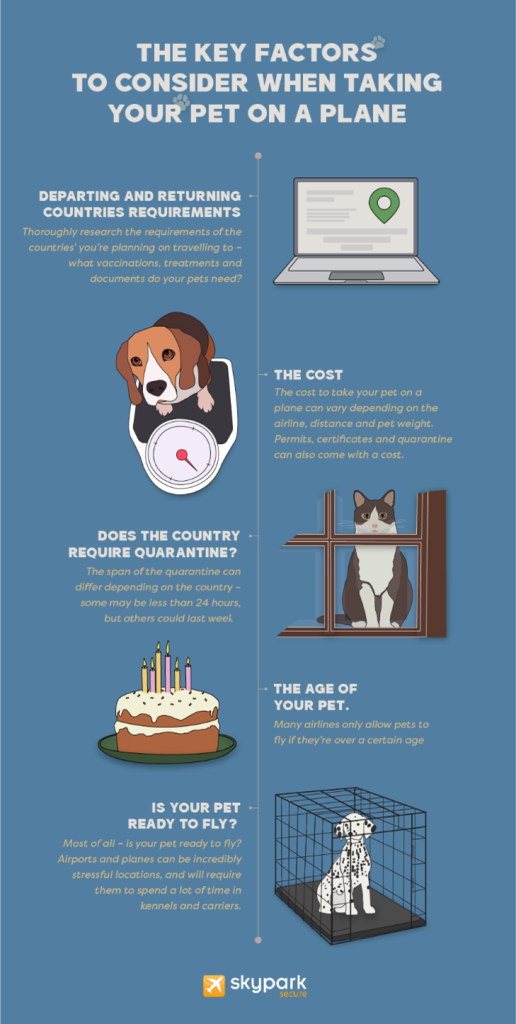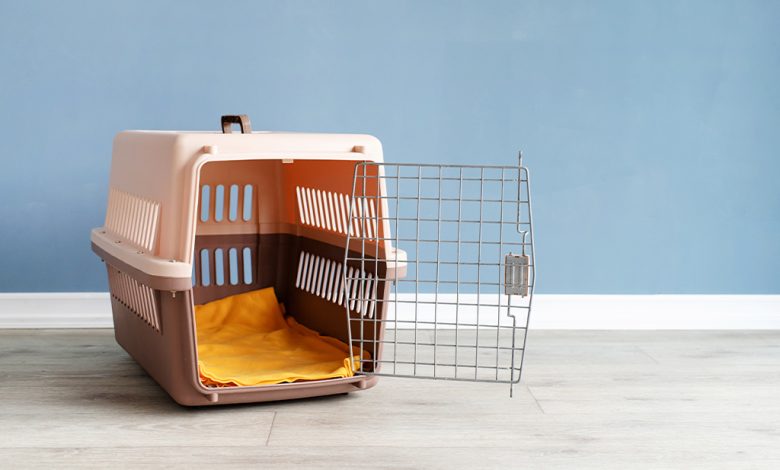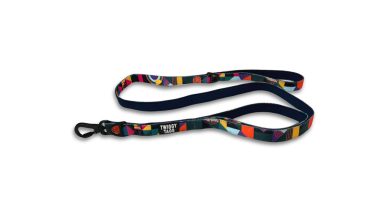Experts reveal the best way to get ready for a car or plane journey
- SkyParkSecure have teamed up with animal expert Adem Fehmi on how to prepare your dogs for long journeys either by car, or by plane.
- Adem Fehmi is a dog behaviourist from Barking Heads.
- More and more of us want our pets to join us on holiday – especially abroad, with searches for ‘taking dogs on holiday abroad’ increasing by 240% in the last year.
Going on holiday is something we all look forward to – leaving our pet behind however, isn’t. In the last few years, there has been a surge in ‘pet holidays’ – whether it’s staycations, road trips or holidays abroad as more and more places become suitable for pets. It was recently revealed that almost 30% of UK pet owners were planning to take a holiday with their pets in 2023, with 9% of those planning on going overseas.
However, our pets aren’t as accustomed to the jet set life as we are – and can sometimes find long car and plane journeys stressful. Travel experts SkyParkSecure have outlined what you need to take into consideration when taking your pets abroad, and if you’re planning a scenic road trip, have teamed up with Adem Fehmi, a dog behaviourist from Barking Heads on how to prepare dogs for long car journeys.
Travelling by Plane
Taking your pets on a plane is considerably trickier (and more expensive) than taking them on a car journey – with different airlines and different countries having varies rules and regulations, meaning it’s incredibly important to do you research beforehand.
Some countries – such as Australia, New Zealand, Japan, and Fiji all require pet quarantine upon arrival in the country – some quarantine stays are brief, but some can be weeks long, and some countries may onto have a few facilities meaning having to travel into a specific airport or long journey to pick your pet up. In this case, it’s probably best to only take your pets to countries requiring a longer quarantine if you’re saying for a long time or moving there for the foreseeable future.
Most countries, however, will usually accept a valid health certificate and have requirements for your pet prior to flying – such as being micro-chipped, vaccinated and tapeworm treatments. Due to Brexit, the rules for UK travellers wanting to travel to EU countries or Northern Ireland changed in 2021 and the EU Pet Certificates became invalid. You now need an animal health certificate, with your pet satisfying EU pet travel rules, and upon re-entering the UK, your pet must meet the requirements of the UK Pet Travel Scheme.
Now you’ve done your research, and you’re ready to take your pet on holiday – can they sit beside you on the plane? Or do they have to go in cargo? Again, this differs depending on airlines, and can also depend on the size of your animal. Some airlines don’t allow pets to travel on their planes at all (with the exception of guide dogs) whilst others may only allow pets to travel in the hold.
Some airlines will allow you to take your pet into the cabin with you – usually cats and dogs, but some also allow other small animals, such as birds! However – like hand luggage requirements, there are usually weight and size limits in place, so larger dogs will have to go into cargo. Many airlines also have age requirements in place.
The key factors to consider when taking your pet on a plane:
- Departing and returning countries requirements – make sure you thoroughly research these, what vaccinations and treatments do your pets need? Is there a certain window these need to be done by before flying?
- The cost – the cost to take pets on a plane can vary depending on airlines, and if you wanted them in the cabin with you, or in the hold. Prices can also vary depending on route, distance, and pet weight. Keeping your pet in quarantine can also come with expensive fees, as can getting permits and certificates.
- Does the country you’re travelling to require quarantine? If you’re travelling to a country that does – is it worth taking your pet if you’re only there for a short while? Some quarantine periods are only a few days, or even less than 24 hours – but others can span for weeks. The need for quarantine, and how long can also depend on the home country and breed of the pet.
- The age of your pet – many airlines will only allow pets of a certain age to travel onboard, whilst some vaccinations may also require your pet to be a certain age.
- Is your pet ready to fly? Whilst it’s heartbreaking leaving your pet behind when going on holiday – is your pet prepared to fly? Airports and planes can be an incredibly stressful environment for pets and will usually require them to spend a lengthy amount of time in kennels or carriers.
If you are worried about your furry best friend being stressed on a flight – there are a few things, you can do to help alleviate their stress:
- Speak to their vet for a professional opinion and guidance. This will usually be a requirement as they’ll be issuing a health certificate, but they will also be able to provide you with advice on how to make your pet feel comfortable.
- Ensure that your pet is familiar with carrier already. Leave it out at home for a while to let them get used to it and feed them in the kennel to develop a positive association, and that it’s big enough to allow a range of movement.
- Include toys and familiar bedding and blankets to keep them entertained and as comfortable as possible – chew toys or chewy treats for take-off and landing are great as we’re not the only ones who get sore ears due to the cabin pressure!
- Boarding early – this is a great option if it’s available, especially if you’re bringing your pet into the cabin with you. Making sure your pet is comfortable and in the correct position can take a little longer than if you had a bag, an extra few minutes can make a world of difference.

Travelling by car
Travelling with dogs
Travelling by car can be considerably easier – but can include some lengthy preparation and training, especially if your pet isn’t familiar with riding in a car, or it’s going to be a long journey. If you’re driving to a different country – the same rules and regulations apply than if you were flying.
Staycation or abroad however, gives you a lot more freedom with your time and schedule – and allows you to have your pet close by at all times. SkyParkSecure spoke to Adem Fehmi, a dog behaviourist from Barking Heads on how to prepare dogs for long car journeys and travel safety.
On travelling with your dog, Adem explains “many of us travel in a car with our dogs, some frequently and others more rarely. Just like we ensure all human passengers are strapped in safely for every journey we need to make sure the same is true for our dogs”.
So, with safety in mind, here are Adem’s best tips for travelling safely with your dog in a car.
Acclimatize your dog to your vehicle – Ensure your dog is confident and happy travelling in your car. Whether you ask your dog to jump into the car, pick them up or even use a ramp, ensure that you build up to this slowly and reward your dog for completing the action calmly. Remember, travelling in a car is not ‘natural’ for a dog and so we must teach them slowly that it is nothing to be fearful of. Once your dog has mastered getting into the car, practice securing them safely in or with your chosen device (more on how to do this shortly), turning the engine on and then perhaps also the radio. Calming music on the radio can be useful at this stage. Practice this in stages and allow your dog to get used to each part of the routine before introducing the next. Once your dog is comfortable with this, you can then commence taking short journeys, building up to longer journeys over time. Some dogs will take to travelling in a car quickly whilst others may need more time to build their confidence. Remember to work at your dog’s pace and reward the progress they make with a tasty treat.:
Safety Harnesses – These items work much like a seat belt for a human. A good harness will ensure that in the event of an accident the harness will stop the dog from travelling forwards or across the vehicle and will distribute the weight of the dog evenly across the straps so that they do not ‘cut into’ your dog. It is important to ensure that the harness you choose is suitable for the breed and size of your dog and fits correctly.
On how to introduce a harness to your dog, Adem explains:
“It is important to note that this device may be better suited to a calmer dog who is used to travelling. As with all tools that you use, it is important to positively introduce the harness slowly and with positive reinforcement of calm and accepting behaviour. You want to make the wearing of the harness a positive experience, not one to be feared. You could start by simply letting your dog interact and sniff the harness, progressing onto laying it gently on their back so they get used to the weight and feel of it, before building up to your dog wearing the harness unclipped. The final step of your introduction would then be to clip the harness securely around your dog but don’t rush this process.”
Dog Crates – Due to their size and shape, these are best situated in the boot of your car. A dog crate can also be a good choice for longer journeys as they allow your dog to be able to stretch out and relax. Some are also crash tested, so it is worth doing your research into the various types available if this is your chosen method of securing your dog in the car.
A dog crate can also be a useful choice if you are travelling via a van or truck, and some can be tailor made and secured directly to your vehicle with a ‘lockable’ front or opening. In this instance these also prove a great choice if you want to be able to pop your dog away but leave your vehicle open for ventilation.
Dog Hammocks – These are exactly as they sound – a large ‘hammock’ type device, predominantly made of fabric, that allows your dog to lay down and stretch out across the back seats of your car. A dog hammock creates a secure cavity, much like the boot of your car, but with the added benefit of soft ‘walls’. They also allow you to use your boot for storage still. They typically span the whole width of your car, and this means they are often not suitable if you intend to have human passengers in the back of your car also.
If choosing this option, make sure you look for a dog hammock that allows your dog to be clipped or strapped in via a harness type device so that your dog is fully secured.
Dog Guards – These devices fill the gap between the top of your back seats and the roof of your car, providing a barrier. These allow your dog to relax in your car boot and stop them from being able to climb over the back seats. They also help to prevent your dog from becoming a flying missile and moving through the gap above the back seats in the event of an accident.






